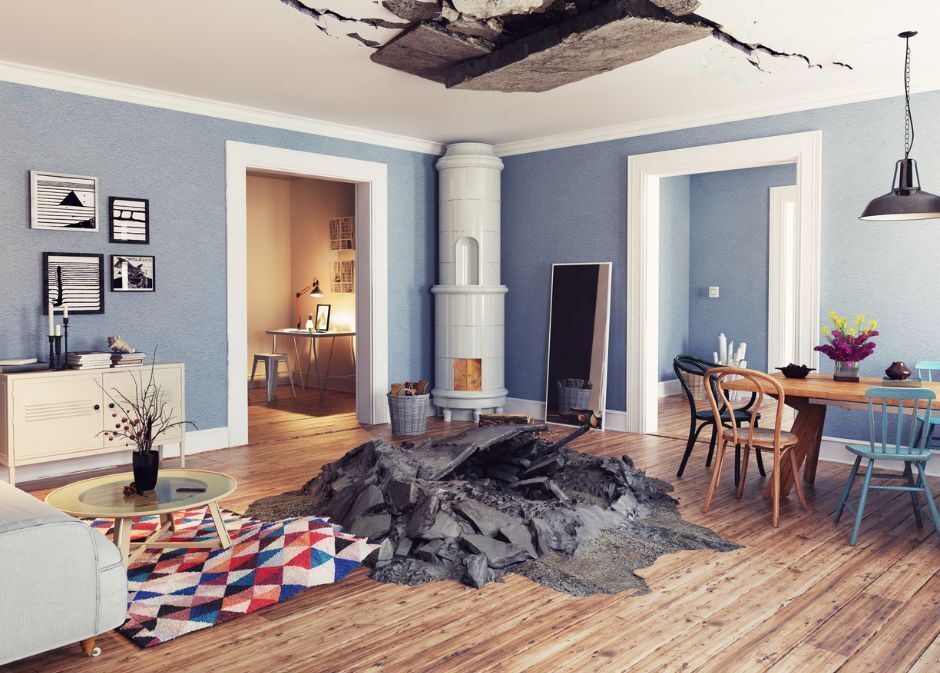Edmonton Ceiling Repair
Efficient Ceiling Repair Services in Edmonton, AB

Your ceiling can (and probably will) go through several problems throughout its life span. Even if your ceiling has protection for most kinds of harmful agents or natural disasters, general wear and tear will make it more prone to damages over the years.
If you keep your ceiling in optimal condition, you will have fewer problems to worry about. Severe cases may require an appropriate ceiling repair service, such as holes, cracks, peeling paint, bad insulation, water damage and more.
A plaster ceiling repair may seem like a daunting task, but you don’t have to deal with it yourself. If you were looking for “ceiling repair near me,” you don’t have to look further since the team at Innovation Drywall of Edmonton is ready and willing to help you with repairing or replacing your ceiling (drywall).
Ceiling damage will eventually worsen if you let it stay for months. Patching your ceiling with drywall may seem like a small thing to do, but if you do it fast, you will save time, money, and stress on future repairs.
There are several factors surrounding a drywall ceiling repair, and we will go over all of them so that you know what to expect from our services. Whether you want to deal with cracks in the ceiling (drywall) or popcorn ceiling with water damage, you can request a free consultation today via phone call or by filling out our contact form.
Why Do Ceilings Get Damaged?
Ceilings can get damaged by several different factors. Those include:
- Mold
- Pests
- Bad insulation
- Peeling paint
- General wear and tear
- Water damage
- Rotting
All of these issues could require a ceiling crack repair or a ceiling water damage repair to get your ceiling back to its original shape. Keep in mind that if you don’t deal with these issues promptly, your home’s internal structure will suffer, which will cause further problems with your ceiling and the rest of your home.
Some homeowners decide not to repair their drywall ceiling until the problem gets worse. Remember, even if you have a small crack in your ceiling, it could develop into something much larger since the integrity of the drywall panels has started to break.
What Can We Do for You?
We aim to be your one-stop shop for all things drywall. If you have any problems with your ceiling, we’re happy to help in a time sensitive way. All you have to do is approve our quote, wait for the job to be done, and enjoy your safe and strong ceiling again.
Here’s an overview of some of the special services we offer homeowners.
Textured Ceiling Repair
Textured ceilings have been an interesting topic of debate among homeowners. While these were fairly popular several decades ago, they have now proven to be a bit of a nuisance. This is because textured ceilings are harder to keep clean, promoting dust, pests, and mold.
In essence, if you don’t take care of your ceilings promptly, you could experience several issues in the future. Repairing a stipple ceiling, for example, requires smoothing out the surface carefully, disposing of the leftover materials, and texturing again if needed. In some cases, a stipple ceiling repair isn’t enough, so you will need to make a full replacement.
Some want to keep their popcorn ceiling, but damage has been sustained. Overall, those who want to fix their popcorn ceiling must assess whether a repair or a completely new drywall installation is necessary. However, we’ll make sure your popcorn ceiling crack repair service is cost-effective and fast if a repair is needed.
Other services that we offer regarding textured ceilings include:
- General popcorn ceiling removal
- General stucco ceiling repair
- General knockdown ceiling repair
- General stipple ceiling repair
- General drop ceiling repair
Water-Damage Ceiling Repair
A wet ceiling repair service is imperative if you notice water leaking out of the ceiling, wet spots, or rotting. Repairing water-damaged drywall is a bit complicated considering that it will most likely require the removal of the drywall panel to install a new one.
If you want to repair your drywall ceiling, you must first talk to our experts to assess the damage. Once we know what’s wrong, we can go ahead and give you an overview of what you will need. In case you need to repair a popcorn ceiling with water damage, for example, we’ll give you a cost-effective quote for those particular services too.
What Is the Average Drywall Ceiling Repair Cost?
Cost is a big factor in repairs. A bathroom ceiling repair, for instance, will not incur the same cost as a replacement. Whether you’re looking for a ceiling repair (water damage) cost or a ceiling replacement cost, here are some of the factors that could influence how much the price is:
- The severity of the ceiling damages
- Tear down and installation (if needed)
- Materials used
- Texturing or painting (if needed)
- Workers’ fees
- Size of the room
Frequently Asked Questions
Do you have a broken or damaged ceiling? You might be wondering what it would take to restore it. We've drawn up a list of FAQs to help you understand a little more about ceiling repair and what we can do to fix it. Read on for more information about ceiling damage and repair work.
Didn't find answers to your questions? You can get in touch with us, and we will gladly address any of your concerns and provide the information you need to make informed decisions about your next home improvement project.
To get in touch with us, give us a call or complete the contact form, and we will call you back!
Don’t Look Further for Ceiling Repair in Edmonton | Contact Our Ceiling Repair Contractors Today!
We know how frustrating dealing with ceiling damages is, but you’re not alone. Our team of drywall contractors is ready to help you get your ceiling to its best possible shape. Thanks to our years of experience, we’re able to provide prompt and professional service to all homeowners in Edmonton, Alberta.
In case you’re interested in our contractors for ceiling repairs, all you have to do is schedule a consultation through our contact form here or call us directly via phone.

